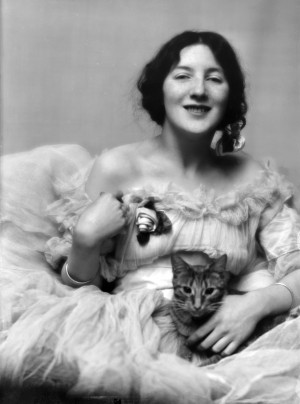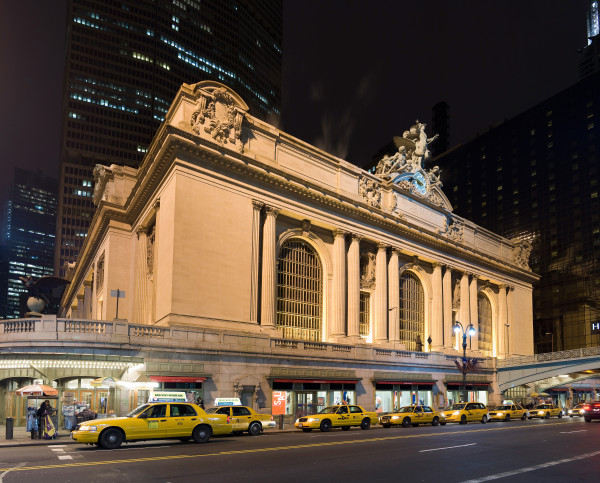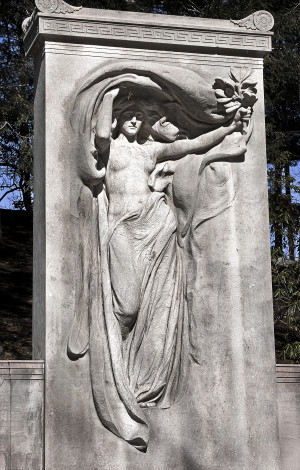All over New York City, there is a woman in various states of undress, so baked into architecture that we barely even notice her. In the public library, she leans against a white horse; at the intersection of 59th and 5th, she perches atop a fountain; on 107th and Broadway, she reclines on a bed; and on top of the Manhattan Municipal Building she stands tall, this time cast in gold. She has gone by many names: Star Maiden, Priestess of Culture, Mourning Victory, and, simply: Niche Figure. But the truth is, all these likenesses were based on a single person: a model by the name of Audrey Munson.

Audrey Munson was once the most famous artist’s model in the United States. Over 30 statues at the Metropolitan Museum of Art were made in her likeness, and she adorns dozens of memorials and bridges and buildings all over the city. Although the body and face of Audrey Munson have been immortalized in iron and marble, her name is mostly forgotten. In the early 20th century, however, she was famous.
Like so many supermodels that would come after her, Audrey Marie Munson was scouted on the streets of New York City in 1906. Her mother, recently divorced, moved with her to the Big City for a fresh start. A photographer approached her one day and gave Audrey his card, asking if she would pose for some portraits. Her mom was invited too. Intentions were good. These photoshoots were fully-clothed affairs.

After some success, the photographer introduced Munson to his friend and famous sculptor Isidore Konti. He, too, was interested in hiring Munson for his work. But for this endeavor she would have to pose “in the altogether” (without clothes). She and her mother agreed. For decades, the resulting sculptural set (three muses, all patterned after Audrey) was in the lobby of the Hotel Astor. Audrey called this statue “a souvenir of my mother’s consent.”
Audrey began to work for many other famous artists in New York, and her reputation grew. She was known for being able to evoke a mood with her posture and expression and could hold poses for as long as needed. In 1913, The New York Sun dubbed her “Miss Manhattan.”
She worked closely with the artists, learning their temperaments, familiarizing herself with their work. She thought of herself as a collaborator. She made about $35 per week (about 800 in today’s dollars). It helped that the architecture that was in vogue at the time was the Beaux-Arts style, which required a lot of sculptures and detailed ornamentation.

As the Beaux-Arts style grew in popularity and started spreading west, Audrey followed, both in flesh and in sculpture. Her likeness now adorned capitol buildings and halls and monuments on both coasts. In fact, at a 1915 world’s fair in San Francisco, the World Panama–Pacific International Exposition, three-quarters of the statues on the grounds were modeled after her. There was even a map highlighting all of her locations on the site.
Once out west, she wound up in Hollywood, where she was always cast in the role of a model. The modeling bit was really the only part she could play, for her skill at evoking a mood and conveying expression seemed to end the moment she broke pose. She was even given an acting double in some cases–who did everything except the non-moving parts.
Her career might have survived a failure in the film industry, but she also became embroiled in a murder scandal. A delusional neighbor in New York killed his wife so he could be with Audrey. On the fiasco, she wrote: “The Wilkins case ruined my career. I’ll never account for anything again. From loving and admiring me, the public seems to have grown to hate me.” Despite having no direct involvement in the scandal, Audrey could not find work.
There were other headwinds blocking her at this point, too. At thirty, Audrey was getting old for a model in that day. And the architectural landscape was shifting as well; Modernism was on the rise and the costs associated with the ornamentation and intricacies of the Beaux-Arts style were becoming a concern.
So Audrey left the city and moved upstate with her mother, but she could never quite get used to small-town life. She would roller-skate along the unpaved country roads and wear glamorous clothes from her previous life in the big city. The locals thought it strange, and she felt a sense of longing for where she had been and of not belonging where she was. On May 27, 1922, Audrey Munson attempted suicide.
Afterward, Audrey’s mother tried to care for her, but it proved too much for her to handle. Years later, on Audrey’s 40th birthday, her mother checked her into the state mental institution. She remained institutionalized into her 90’s but was eventually moved to a nursing home thirty miles up the road.
This move, however, did not last long. The nursing home sat across from a strip mall which housed a bar. She was known to sneak out of the home and across the four-lane highway to spend her evenings ordering drinks and telling stories of her times as a model and actress. Sadly, this caused her caregivers to send her back to the mental institution, where she died in 1996, just short of her 105th birthday.

And so this public body that had once represented truth, civic fame, memory, the universe and the stars, was hidden away for nearly two-thirds of her life. But that one glorious third immortalized Audrey Munson and placed her all over American cities, where she remains today, perched on high, quietly watching over the cities she helped build.
“I am wondering if many of my readers have not stood before a masterpiece of lovely sculpture or a remarkable painting of a young girl,” mused Audrey, early in her career but with an eye to the future, “and asked themselves the question: ‘Where is she now, this model who was so beautiful? What has been her reward? Is she happy and prosperous or is she sad and forlorn, her beauty gone, leaving only memories in the wake?'”



Comments (12)
Share
LOVED this story!!! LOVE LOVE LOVE LOVE LOVE!!
I will never walk down the streets of NYC the same again.
OHHH! I love it! So glad you did a write up on Ms. Audrey… fascinating character (I did the video in the article;)
This is a sad story. I’ve seen Star Maiden at the Crocker Bank in Downtown San Francisco. It is really beautiful.
And of course I’ve always loved the Weeping Women on top of the Colonnade of the Palace of Fine Arts.
Alma Spreckles was the model for the sculpture atop the Dewey Monument in Union Square. She became the wife of one of the wealthiest men on the West Coast because he saw her in sculpture and asked to meet her. I won’t try to tell her story here as it is long and fascinating and deserves more than a comment on a blog. She was a truly remarkable woman. I encourage you to read her Biography “Big Alma”. Some topics: Royalty, Rodin, the Navy, Architecture, Swearing, Syphillis, Ships, Sugar, Hawaii, Museums, Patronage, Lesbian Dancers, Paris, …
Trip to NYC on the docket this year to see Audrey!…..Great podcast and story….
Interesting. I had just heard about Audrey Munson for the first time last week in the wonderful episode titled “Sex in Monochrome” of the impressive Secret History of Hollywood podcast. What happened to her is a real tragedy and a profound injustice. Institutionalized for 65 years? I can’t even imagine. Her story deserves wider notice for sure.
Thank you for this lovely, touching piece on Audrey Munson. I think of her as my guardian angel, all around New York.
I didn’t know she supported the Suffrage movement!
Excellent episode; thank you. I’m happy to see there’s so much information about her online, now that I’ve been reminded to look for the name.
Does anybody know of a map of her statues in NYC? Would love to do a walking tour around town on a nice weekend. Haven’t been able to find one on Google.
http://www.andreageyer.info/projects/audrey_munson/munson_notebooks/munson.htmlhttp://www.andreageyer.info/projects/audrey_munson/munson_notebooks/munson.html
http://www.andreageyer.info/projects/audrey_munson/munson_notebooks/munson_thisSiteofMemory.htm (direct link to map)
there is a link to a map there
Now, Vogue.
http://www.vogue.com/13426835/the-curse-of-beauty-audrey-munson/
Funny how an era that we consider to be incredibly prudish and repressed could produce so much nude artwork — art that would probably be far more controversial if it were created today.
Anyway, a very sad and moving story. But Audrey will apparently have the last laugh… as her form will continue to grace the cities of America long after anyone living today is gone.
I think I glimpsed her face on a quick shot of an NYC statue in “The Big Short,” then a few hours later I came across a little 1916 article about her film, “Purity.” I thought people here might enjoy: http://archive.org/stream/motionpicturenew133unse#page/4052/mode/2up